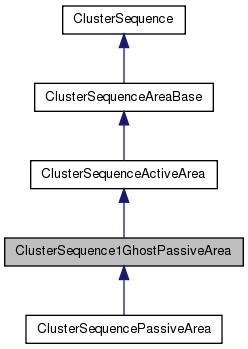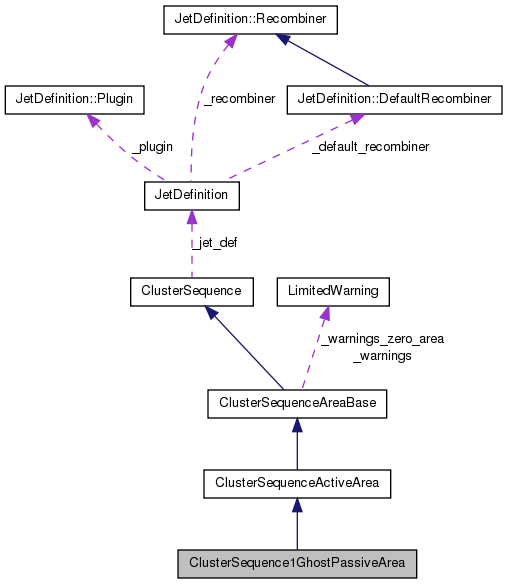Class that behaves essentially like ClusterSequence except that it also provides access to the area of a jet (which will be a random quantity... More...
#include <ClusterSequence1GhostPassiveArea.hh>


Public Member Functions | |
| ClusterSequence1GhostPassiveArea () | |
| template<class L > | |
| ClusterSequence1GhostPassiveArea (const std::vector< L > &pseudojets, const JetDefinition &jet_def, const GhostedAreaSpec &area_spec, const bool &writeout_combinations=false) | |
| constructor based on JetDefinition and 1GhostPassiveAreaSpec | |
| virtual double | n_empty_jets (const RangeDefinition &range) const |
| return an estimate for the number of empty jets -- one uses the AreaBase one rather than the ActiveArea one (which for which we do not have the information). | |
Protected Member Functions | |
| void | _initialise_and_run_1GPA (const JetDefinition &jet_def, const GhostedAreaSpec &area_spec, const bool &writeout_combinations=false) |
| does the initialisation and running specific to the passive areas class | |
Private Member Functions | |
| void | _run_1GPA (const GhostedAreaSpec &area_spec) |
| routine for running a passive area one ghost at a time. | |
Detailed Description
Class that behaves essentially like ClusterSequence except that it also provides access to the area of a jet (which will be a random quantity...
Figure out what to do about seeds later...)
Definition at line 49 of file ClusterSequence1GhostPassiveArea.hh.
Constructor & Destructor Documentation
| ClusterSequence1GhostPassiveArea::ClusterSequence1GhostPassiveArea | ( | ) | [inline] |
Definition at line 52 of file ClusterSequence1GhostPassiveArea.hh.
{}
| ClusterSequence1GhostPassiveArea::ClusterSequence1GhostPassiveArea | ( | const std::vector< L > & | pseudojets, |
| const JetDefinition & | jet_def, | ||
| const GhostedAreaSpec & | area_spec, | ||
| const bool & | writeout_combinations = false |
||
| ) |
constructor based on JetDefinition and 1GhostPassiveAreaSpec
Definition at line 84 of file ClusterSequence1GhostPassiveArea.hh.
{
// transfer the initial jets (type L) into our own array
_transfer_input_jets(pseudojets);
// run the clustering for passive areas
_initialise_and_run_1GPA(jet_def, area_spec, writeout_combinations);
}
Member Function Documentation
| void ClusterSequence1GhostPassiveArea::_initialise_and_run_1GPA | ( | const JetDefinition & | jet_def, |
| const GhostedAreaSpec & | area_spec, | ||
| const bool & | writeout_combinations = false |
||
| ) | [protected] |
does the initialisation and running specific to the passive areas class
global routine for initialising and running a general passive area
Definition at line 40 of file ClusterSequence1GhostPassiveArea.cc.
{
bool continue_running;
_initialise_AA(jet_def, area_spec, writeout_combinations, continue_running);
if (continue_running) {
_run_1GPA(area_spec);
_postprocess_AA(area_spec);
}
}
| void ClusterSequence1GhostPassiveArea::_run_1GPA | ( | const GhostedAreaSpec & | area_spec | ) | [private] |
routine for running a passive area one ghost at a time.
Definition at line 56 of file ClusterSequence1GhostPassiveArea.cc.
{
// record the input jets as they are currently
vector<PseudoJet> input_jets(_jets);
// code for testing the unique tree
vector<int> unique_tree;
// initialise our temporary average area^2
valarray<double> lcl_average_area2(0.0, _average_area.size());
valarray<double> last_average_area(0.0, _average_area.size());
// run the clustering multiple times so as to get areas of all the jets
for (int irepeat = 0; irepeat < area_spec.repeat(); irepeat++) {
// first establish list of all ghosts
vector<PseudoJet> all_ghosts;
area_spec.add_ghosts(all_ghosts);
// then run many subsets of ghosts (actually each subset contains just one ghost)
for (unsigned ig = 0; ig < all_ghosts.size(); ig++) {
vector<PseudoJet> some_ghosts;
some_ghosts.push_back(all_ghosts[ig]);
ClusterSequenceActiveAreaExplicitGhosts clust_seq(input_jets, jet_def(),
some_ghosts, area_spec.actual_ghost_area());
if (irepeat == 0 && ig == 0) {
// take the non-ghost part of the history and put into our own
// history.
_transfer_ghost_free_history(clust_seq);
// get the "unique" order that will be used for transferring all areas.
unique_tree = unique_history_order();
}
// transfer areas from clust_seq into our object
_transfer_areas(unique_tree, clust_seq);
}
// keep track of fluctuations in area
lcl_average_area2 += (_average_area - last_average_area)*
(_average_area - last_average_area);
last_average_area = _average_area;
}
_average_area2 = lcl_average_area2;
}
| virtual double ClusterSequence1GhostPassiveArea::n_empty_jets | ( | const RangeDefinition & | range | ) | const [inline, virtual] |
return an estimate for the number of empty jets -- one uses the AreaBase one rather than the ActiveArea one (which for which we do not have the information).
Reimplemented from ClusterSequenceActiveArea.
Definition at line 64 of file ClusterSequence1GhostPassiveArea.hh.
{
return ClusterSequenceAreaBase::n_empty_jets(range);
}
The documentation for this class was generated from the following files:
- include/fastjet/ClusterSequence1GhostPassiveArea.hh
- src/ClusterSequence1GhostPassiveArea.cc
 1.7.3
1.7.3